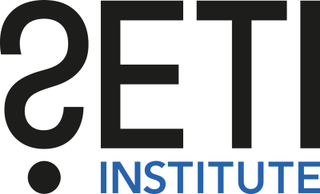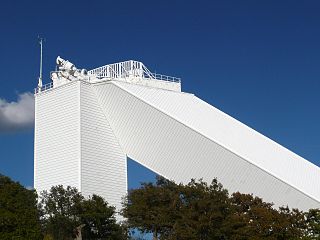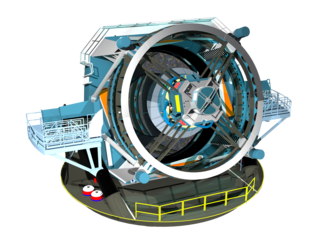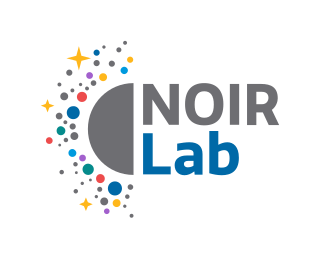
An astronomer is a scientist in the field of astronomy who focuses their studies on a specific question or field outside the scope of Earth. They observe astronomical objects such as stars, planets, moons, comets and galaxies – in either observational or theoretical astronomy. Examples of topics or fields astronomers study include planetary science, solar astronomy, the origin or evolution of stars, or the formation of galaxies. A related but distinct subject is physical cosmology, which studies the Universe as a whole.

The Kitt Peak National Observatory (KPNO) is a United States astronomical observatory located on Kitt Peak of the Quinlan Mountains in the Arizona-Sonoran Desert on the Tohono Oʼodham Nation, 88 kilometers (55 mi) west-southwest of Tucson, Arizona. With more than twenty optical and two radio telescopes, it is one of the largest gatherings of astronomical instruments in the Earth's northern hemisphere.

The Space Telescope Science Institute (STScI) is the science operations center for the Hubble Space Telescope (HST), science operations and mission operations center for the James Webb Space Telescope (JWST), and science operations center for the Nancy Grace Roman Space Telescope. STScI was established in 1981 as a community-based science center that is operated for NASA by the Association of Universities for Research in Astronomy (AURA). STScI's offices are located on the Johns Hopkins University Homewood Campus and in the Rotunda building in Baltimore, Maryland.

The Robert C. Byrd Green Bank Telescope (GBT) in Green Bank, West Virginia, US is the world's largest fully steerable radio telescope, surpassing the Effelsberg 100-m Radio Telescope in Germany. The Green Bank site was part of the National Radio Astronomy Observatory (NRAO) until September 30, 2016. Since October 1, 2016, the telescope has been operated by the independent Green Bank Observatory. The telescope's name honors the late Senator Robert C. Byrd who represented West Virginia and who pushed the funding of the telescope through Congress.

The Gemini Observatory comprises two 8.1-metre (26.6 ft) telescopes, Gemini North and Gemini South, situated in Hawaii and Chile, respectively. These twin telescopes offer extensive coverage of the northern and southern skies and rank among the most advanced optical/infrared telescopes available to astronomers. (See List of largest optical reflecting telescopes).

The National Optical Astronomy Observatory (NOAO) was the United States national observatory for ground-based nighttime ultraviolet-optical-infrared (OUVIR) astronomy. The National Science Foundation (NSF) funded NOAO to provide forefront astronomical research facilities for US astronomers. Professional astronomers from any country in the world could apply to use the telescopes operated by NOAO under the NSF's "open skies" policy.

The SETI Institute is a not-for-profit research organization incorporated in 1984 whose mission is to explore, understand, and explain the origin and nature of life in the universe, and to use this knowledge to inspire and guide present and future generations, sharing knowledge with the public, the press, and the government. SETI stands for the "search for extraterrestrial intelligence".

The Association of Universities for Research in Astronomy (AURA) is a consortium of universities and other institutions that operates astronomical observatories and telescopes.

The Canada–France–Hawaii Telescope (CFHT) is located near the summit of Mauna Kea mountain on Hawaii's Big Island at an altitude of 4,204 meters, part of the Mauna Kea Observatory. Operational since 1979, the telescope is a Prime Focus/Cassegrain configuration with a usable aperture diameter of 3.58 metres (11.7 ft).

McMath–Pierce solar telescope is a 1.6 m f/54 reflecting solar telescope at Kitt Peak National Observatory in Arizona, United States. Built in 1962, the building was designed by American architect Myron Goldsmith and Bangladeshi-American structural engineer Fazlur Rahman Khan. It was the largest solar telescope and the largest unobstructed aperture optical telescope in the world. It is named after the astronomers Robert Raynolds McMath and Keith Pierce.

Associated Universities, Inc. (AUI) is a research management corporation that builds and operates facilities for the research community. It is a not-for-profit 501(c)(3) corporation headquartered in Washington, D.C., United States. The current president is Adam Cohen. The corporation's major current operating unit is the National Radio Astronomy Observatory, which it operates under a Cooperative Agreement with the National Science Foundation.

The Infrared Processing and Analysis Center (IPAC) provides science operations, data management, data archives and community support for astronomy and planetary science missions. IPAC has a historical emphasis on infrared-submillimeter astronomy and exoplanet science. IPAC has supported NASA, NSF and privately funded projects and missions. It is located on the campus of the California Institute of Technology in Pasadena, California.

The Vera C. Rubin Observatory, previously referred to as the Large Synoptic Survey Telescope (LSST), is an astronomical observatory currently under construction in Chile. Its main task will be carrying out a synoptic astronomical survey, the Legacy Survey of Space and Time (LSST). The word synoptic is derived from the Greek words σύν and ὄψις, and describes observations that give a broad view of a subject at a particular time. The observatory is located on the El Peñón peak of Cerro Pachón, a 2,682-meter-high mountain in Coquimbo Region, in northern Chile, alongside the existing Gemini South and Southern Astrophysical Research Telescopes. The LSST Base Facility is located about 100 kilometres (62 mi) away by road, in the town of La Serena. The observatory is named for Vera Rubin, an American astronomer who pioneered discoveries about galaxy rotation rates.
The Astrophysical Virtual Observatory (AVO) project conducted a research and demonstration programme on the scientific requirements and technologies necessary to build a virtual observatory for European astronomy. The AVO has been jointly funded by the European Commission with six European organisations participating in a three-year Phase-A work programme, valued at 5 million euro. The partner organisations were the European Southern Observatory (ESO) in Munich, Germany, the European Space Agency (ESA), AstroGrid, the CNRS-supported Centre de Données Astronomiques de Strasbourg (CDS), the University Louis Pasteur in Strasbourg, France, the CNRS-supported TERAPIX astronomical data centre at the Institut d'Astrophysique in Paris, France, and the Jodrell Bank Observatory of the Victoria University of Manchester, United Kingdom.
A virtual observatory (VO) is a collection of interoperating data archives and software tools which utilize the internet to form a scientific research environment in which astronomical research programs can be conducted.

In 2011, Chile was home to 42% of the world's astronomical infrastructure, consisting principally of telescopes. In 2015, it was estimated that Chile would contain more than 50% of the global astronomical infrastructure by 2030. In the Atacama desert region of northern Chile, the skies are exceptionally clear and dry for more than 300 days of the year. These conditions have attracted the world's scientific community to develop highly ambitious astronomical projects in the Atacama desert.

Charles Mattias ("Matt") Mountain is currently the President of the Association of Universities for Research in Astronomy (AURA) which designs, builds, and operates telescopes and observatories for the National Science Foundation (NSF) and the National Aeronautics and Space Administration (NASA). AURA's NASA center is the Space Telescope Science Institute (STScI), responsible for the science mission for the Hubble Space Telescope, the science and operations for the James Webb Space Telescope, and the MAST data archive. AURA's NSF centers are Gemini Observatory, the National Optical Astronomy Observatory (NOAO), and the National Solar Observatory (NSO). Dr. Mountain and AURA are also responsible for the NSF construction projects: the Daniel K. Inouye Solar Telescope (DKIST) on Haleakalā, Hawaii and the Large Synoptic Survey Telescope (LSST) on Cerro Pachón in Chile.

Richard Frederick Green is an American astronomer, former director of the Kitt Peak National Observatory, UKIRT and the Large Binocular Telescope Observatory.

Dara J. Norman is an astronomer and the deputy director of the Community Science and Data Center at the National Science Foundation's National Optical-Infrared Astronomy Research Laboratory (NOIRLab) in Tucson, Arizona. She is also the Association of Universities for Research in Astronomy Diversity Advocate at NOAO. Her research centers on the influence of Active Galactic Nuclei (AGN) on the evolution of galaxies. In 2020, she was inducted into the inaugural cohort of American Astronomical Society Fellows in recognition of her leadership and achievements.

NSF’s NOIRLab is a United States federally funded research and development center for ground-based, nighttime optical and infrared astronomy.

















